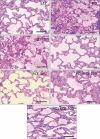Bark extract of Bathysa cuspidata attenuates extra-pulmonary acute lung injury induced by paraquat and reduces mortality in rats
- PMID: 22429505
- PMCID: PMC3385921
- DOI: 10.1111/j.1365-2613.2012.00808.x
Bark extract of Bathysa cuspidata attenuates extra-pulmonary acute lung injury induced by paraquat and reduces mortality in rats
Abstract
This study investigated the effect of the bark extract of Bathysa cuspidata on paraquat (PQ)-induced extra-pulmonary acute lung injury (ALI) and mortality in rats. ALI was induced with a single dose of PQ (30 mg/kg, i.p.), and animals were treated with B. cuspidata extract (200 and 400 mg/kg). Analyses were conducted of survival, cell migration, lung oedema, malondialdehyde, proteins carbonyls, catalase, superoxide dismutase, histopathology and the stereology of lung tissue. Rats exposed to PQ and treated with 200 and 400 mg of the extract presented lower mortality (20% and 30%), compared with PQ alone group (50%). Furthermore, lung oedema, septal thickening, alveolar collapse, haemorrhage, cell migration, malondialdehyde and proteins carbonyl levels decreased, and catalase and superoxide dismutase activity were maintained. These results show that the bark extract of B. cuspidata reduced PQ-induced extra-pulmonary ALI and mortality in rats and suggest that these effects may be associated with the inhibition of oxidative damage.
© 2012 The Authors. International Journal of Experimental Pathology © 2012 International Journal of Experimental Pathology.
Figures





References
-
- Aebi H. Catalase in vitro. Methods Enzymol. 1984;105:121–126. - PubMed
-
- Bradford M. A rapid and sensitive method for quantitation of microgram quantities of protein utilizing the principle of protein-dye-binding. Anal. Biochem. 1976;72:248–254. - PubMed
-
- Dasta JF. Paraquat poisoning: a review. Am. J. Hosp. Pharm. 1978;35:1368–1372. - PubMed
-
- Day BJ, Crapo JD. A metalloporphyrin superoxide dismutase mimetic protects against paraquat-induced lung injury in vivo. Toxicol. Appl. Pharmacol. 1996;140:94–100. - PubMed
MeSH terms
Substances
LinkOut - more resources
Full Text Sources

